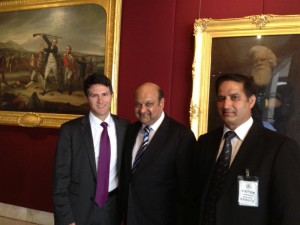A taste of the world to lure Sydney visitors
Minister for Citizenship and Communities Victor Dominello with Nihal Gupta Chair NSW Multicultural Business Advisory Panel Members ”“ 2011 to 2013 and Jaswinder Bhogal
International visitors to Australia are expected to increase at an average annual rate of 3.6% over the 2010-20 period to reach 8.4 million in 2020.
Destination NSW is planning for extraordinary growth in visitor numbers and associated spending from the developing markets of China and India.
China is NSW’s fastest growing markets and is already, its largest contributor of visitor nights (16%).
The Indian market now ranks as no. 10 in NSW’s list of top ten international source markets but is number 6 in terms of its share of NSW visitor nights. Although still developing off a base of about 70,000 per annum, Indian visitors have the longest length of stay in NSW (47.8 nights).
The Tourism Forecasting Council (TFC) expects inbound tourism to Australia from China to increase at an annual average growth rate of 7.2% between 2010-20. Indian visitor arrivals are expected to increase at an annual average growth rate of 8.5% – the highest of all inbound markets.
So the message from NSW government is: “Forget dining at the top of the Eiffel Tower, and cancel your booking at El Bulli ”“ Sydney’s ethnic eat streets offer a world of dining delights which could be worth millions to the NSW economy.”
That’s the message from Minister for Citizenship and Communities Victor Dominello who has asked the Community Relations Commission to look at ways to encourage international visitors to stay an extra night and sample what’s on offer at the restaurants of Cabramatta, Haberfield, Leichhardt, Harris Park and Sydney’s other ethnic eat streets.
Mr Dominello said he wanted to capitalise on Sydney’s multicultural menu, which had been an underutilised asset.
“If we can get some 10 per cent of international visitors to stay just one more night by going out to a great suburban ethnic eat street, that’s worth around $30 million for the economy,” Mr Dominello said.
“Some 35 per cent of Sydney residents were born overseas ”“ that adds up to a lot of overseas family and friends who we should be targeting in our tourism marketing.
“As part of our drive to make the most of our multicultural heritage ”“ and give the economy a boost ”“ I have asked the Community Relations Commission to survey ethnic eat streets across Sydney to see how many international visitors they get, and what the operators think can be done to get more.”
Mr Dominello said Sydney was home to myriad ethnic eat streets and tourists could enjoy all the world’s culinary highlights in the one city.
“For example, Sydney’s Italian district in Haberfield and Leichhardt is home to around 45 Italian eateries plus specialised Italian grocers, bakers, butchers, pasta and cheese shops,” he said.
“Vietnamese Sydney in Cabramatta and Canley Vale has some 40 eateries plus specialised Vietnamese grocers, fishmongers and butchers.
“Locals say the first Indian restaurant in Harris Park opened in 2002. Just 10 years later, Harris Park and Parramatta boast more than 20 Indian eateries and spice shops.
“Selling these experiences to overseas visitors would do more than just benefit the State’s economy ”“ it would also boost local businesses and local jobs.”
Mr Dominello said NSW received nearly 2.8 million international overnight visitors last year. They stayed for a total of more than 68 million nights and spent $6.4 billion in the State.
“Of those visitors, India and China send the most visitors to NSW. At the same time, the local Chinese and Indian communities are among the State’s largest and fastest growing,” he said.
“It’s important we look at the links between our multicultural character and our tourism interests,” Mr Dominello said.
Short URL: https://indiandownunder.com.au/?p=1288

